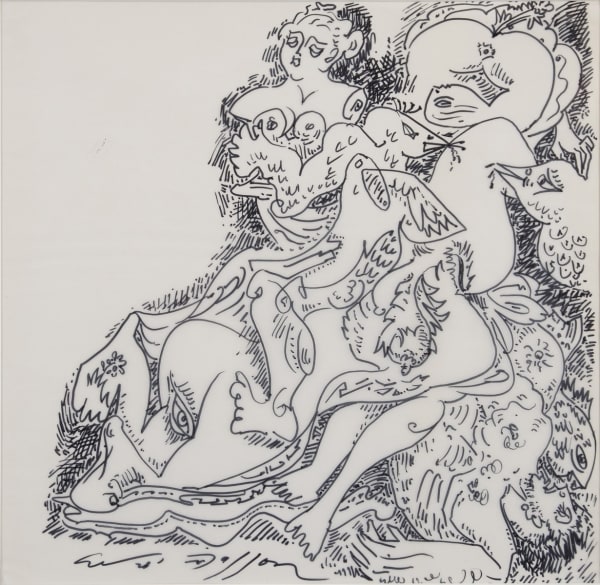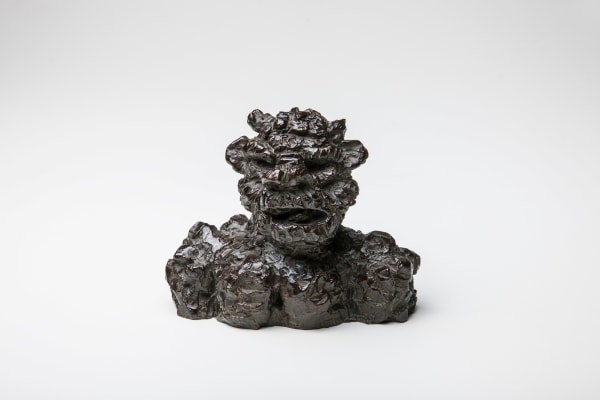Overview
The work of André Masson (1896-1987), a modern and postmodern artist in equal measure, is marked by metamorphosis: an art of instability that stages the eroticism and violence of life. Experimentation without preconception is its fundamental value, a technique always adapted to the internal needs of the work, which spring freely from the artist's vision. One of the founding members of the Surrealist group, André Masson was the inventor of automatic drawing, which he later transposed into painting and even sculpture. In 1927, he laid the foundations of dripping in his sables, and his canvases were to influence the beginnings of American abstract expressionism.
Committed and sensitive to the spirit of his time, the artist maintained fruitful artistic collaborations, notably with Georges Bataille. Masson's art is in continuous renewal. Claiming a “native disposition for variety”, his prolific output is marked by incessant inventiveness, summed up by André Breton's enthusiastic phrase: “L'éclectisme dirige, rien de plus beau”. The exhibition André Masson: Le surréalisme révolutionnaire (André Masson: Revolutionary Surrealism) aims to reveal all the facets of Masson's work: from the artist's cubist beginnings, imbued with a surrealist imagination, through his sables and automatic drawings, to the Massacres of 1932-34, the paroxysm of the century's violence in the artist's work.
Paintings from the American period show the artist's influence on the post-war abstract school on both sides of the Atlantic : American abstract expressionism and French lyrical abstraction. The 1950s also marked Masson's “Chinese period”, in which he again renewed himself, this time by inventing an abstract language inspired by the archaic Chinese pictographic alphabet. All of Masson's creative periods will be represented by some thirty works.An outstanding draughtsman, works on paper by the artist will complete the exhibition, including automatic drawings, a major invention of the surrealist movement. A total artist, several of Masson's major sculptures will also be on show.
Works
-
 André Masson, Poursuite, 1933
André Masson, Poursuite, 1933 -
 André MassonDans la forêt, 1943Bronze sculpture49.5 × 68.3 × 35 cmMonogrammed by the artist and numbered "1/8", with the foundy and gallery mark "Brustolin Verona/ Due Ci"
André MassonDans la forêt, 1943Bronze sculpture49.5 × 68.3 × 35 cmMonogrammed by the artist and numbered "1/8", with the foundy and gallery mark "Brustolin Verona/ Due Ci" -
 André MassonFête , 1956Oil on Canvas90 x 81 cmSigned on the lower left side "André Masson"
André MassonFête , 1956Oil on Canvas90 x 81 cmSigned on the lower left side "André Masson" -
 André MassonJeux d'oiseaux, c. 1965Felt pen on tracing paper35 x 35.5 cm (13 ¾ x 14 in.)Signed on the lower left, "André Masson"
André MassonJeux d'oiseaux, c. 1965Felt pen on tracing paper35 x 35.5 cm (13 ¾ x 14 in.)Signed on the lower left, "André Masson" -
 André Masson, La ville abandonnée, 1923-24
André Masson, La ville abandonnée, 1923-24 -
 André Masson, Le balisier , 1941
André Masson, Le balisier , 1941 -
 André Masson, Le Couple, 1930
André Masson, Le Couple, 1930 -
 André MassonLe Rapt, 1932Oil on canvas24.3 x 33.2 cm
André MassonLe Rapt, 1932Oil on canvas24.3 x 33.2 cm
Monogramed and dated on the lower left «AM -32-»
-
 André Masson, Ville crânienne, 1940
André Masson, Ville crânienne, 1940 -
 André MassonLe Loup-Garou, 1943Pastel and charcoal on paper61 x 45.5 cmSigned on the lower right corner.
André MassonLe Loup-Garou, 1943Pastel and charcoal on paper61 x 45.5 cmSigned on the lower right corner. -
 André MassonPaysage aux deux poissons, 1955Charcoal and pastel on paper.68 x 48 cmSigned on the lower left corner.
André MassonPaysage aux deux poissons, 1955Charcoal and pastel on paper.68 x 48 cmSigned on the lower left corner. -
 André MassonFemme tourmentée, 1942Bronze25,5 × 16 × 13 cmMonogrammé et numéroté, avec la marque du fondeur « AM / 3/6/ Valsuani Cire Perdue»
André MassonFemme tourmentée, 1942Bronze25,5 × 16 × 13 cmMonogrammé et numéroté, avec la marque du fondeur « AM / 3/6/ Valsuani Cire Perdue» -
 André MassonLe Thé chez Franco, 1938Ink on paper45,5 x 58 cmSigned and dated lower left : André Masson 19 novembre 1938.
André MassonLe Thé chez Franco, 1938Ink on paper45,5 x 58 cmSigned and dated lower left : André Masson 19 novembre 1938.
Titled lower center : Le thé chez Franco -
 André Masson, Massacre des chevaux, 1933
André Masson, Massacre des chevaux, 1933 -
 André MassonMétamorphose, 1929Oil on canvas60 x 73 cmSigned on the back.
André MassonMétamorphose, 1929Oil on canvas60 x 73 cmSigned on the back. -
 André Masson, Minotaure I, 1942
André Masson, Minotaure I, 1942

















